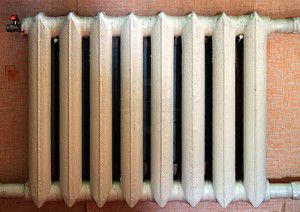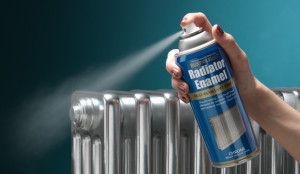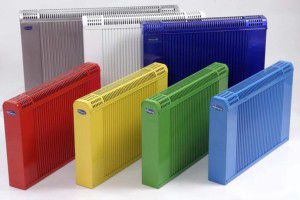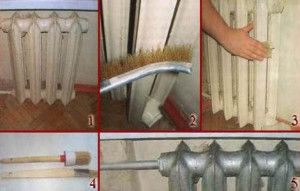One of the methods of preserving the initial appearance and operational properties of the elements of the heating system is to paint their surface. However, the implementation of this work has its own characteristics - from the choice of paintwork to the nuances of preparing a radiator. Is it possible to do this at home and how to paint the batteries and heating pipes, what paint to choose?
Why paint batteries
Changing or updating the protective coating may be necessary in several cases. Frequent of them is the natural wear of the paint layer and then radiators or pipes not only lose their original appearance, but can also fail more quickly. Therefore, before deciding what color to paint the heating batteries, you need to find out the purpose of the coating.
Regardless of the material of manufacture, the battery experiences significant temperature changes during operation. Without a layer of paint, condensation forms on its surface, which provokes the process of rusting. Since it is possible to paint a heating radiator at home - it is recommended to do this if the following external signs occur:
- Change the color of the paint. This indicates a gradual fading and thinning of the protective layer;
- Heterogeneity - places where there is no paint;
- After battery overhaul. Often during this, the protective layer is damaged.
But how to paint a heating radiator, if the current shade does not fit the design of the room? This problem occurs less often, but to solve it, you need to responsibly approach the choice of paints and varnishes. It is important not only the appearance, but also the operational properties of the coating - preservation under the influence of high temperatures, resistance to moisture.
If the radiator is not painted in time, then with time, rust will thin its walls. Even with minimal hydrodynamic shock, the likelihood of a rush will increase.
Choosing paint for heating
Before you properly paint the heating radiator, you need to choose the appropriate type of coating. To do this, be guided by 2 main priorities - safety for humans after application and durability.
Consider the main types of paint that can be used for elements of a heating system. After all, it is precisely on what paint to paint the heating batteries that their appearance and application technology will depend on.
Acrylic
They are made on the basis of organic components. During application, a characteristic odor may appear. But this is perhaps the only drawback. Otherwise, acrylic paints are the best option for updating the protective layer or repainting heating radiators. And if the question arises, what kind of paint to paint the heating pipes - it is recommended to dwell on this form.
The characteristic features of acrylic paint products include:
- Be sure to apply a primer coat before painting. It is necessary for better adhesion with the battery;
- It is recommended to make 2 or 3 layers of protection. So you can minimize the possible swelling of the paint;
- All layers should be the same thickness.
But acrylic compositions have one drawback - a relatively high cost. If the first question is how much it costs to paint a heating radiator, you need to carefully read the assortment from various manufacturers.
Acrylics are quite thick. They can be diluted with water in a proportion specified by the manufacturer. In order to properly paint the heating radiator, it is enough to observe a 1: 1 ratio. The second layer can be made from a thicker composition.
Alkyd paints
They are the best option for systems with high temperature conditions. They perfectly tolerate long-term thermal effects. But before you paint the heating battery with this paint, you need to prepare the room. In the process, there will be an unpleasant odor that will persist for several days.
Features:
- The ability to choose a shade. Depending on what color the radiators will be painted - the interior of the room will change;
- The likelihood of an unpleasant odor after several cycles of the heating system;
- When using a brush, you can apply one coat of protection.
If after a while you want to change the color of the radiators, the paint is relatively easily removed from their surface.
What paint to paint the heating battery - finished or to buy a paste-like concentrate? If the amount of work is small - the first option is recommended.
Waterborne dispersion paints
They are characterized by quick drying, lack of smell and a large selection of colors. But before you paint the heating radiators with this composition, you should carefully read the instructions. It should indicate that this paint is classified as heat-resistant.
Features:
- Do not use formulations based on a polyvinyl acetate dispersion or the like. Such paints are not designed for exposure to high temperatures;
- To obtain the desired color, you can add dye;
- Be sure to have normal air exchange in the room to remove the vapors.
Since it is possible to paint heating pipes with this type of coating, they often make a single type of heating system.
The average paint consumption is 135-175 g / m². But at the same time it is necessary to take into account surface irregularities characteristic of radiators and batteries.
Regardless of which paint the heating pipes are painted on, the costly part of the event must first be calculated. To do this, it is recommended to do a surface analysis of offers on the market from various manufacturers.
| Name | Paint type | price, rub. |
| Lacra, 2.4 kg | Acrylic | 465 |
| Dufa Allgrund, 0.75 L | Acrylic | 375 |
| Tikkurila Miranol, 2.7 kg | Alkyd | 848 |
| PF-115 LUX "Impulse", 2.8 kg | Alkyd | 548 |
It is recommended that you purchase spray paint as additional supplies. Its price will not greatly affect the question of how much it will cost to paint a heating radiator. But if you need to eliminate a small defect without repainting the entire battery - this will be the best option for paint consumption on the heating battery.
The technology of applying paint to heating radiators
Will the color choice affect the characteristics of the radiator? You can paint the heating batteries in almost any shade - this will not damage its characteristics. It is important not to overdo it with layers - 2 or more can reduce heat transfer by 1-2%.
Before painting the heating radiator - you need to thoroughly clean its surface from dirt and dust. Then with the help of solvents the old paint layer is softened. You can remove it with a brush for metal or coarse sandpaper.
This technology is only suitable for cast iron and steel radiators. Bimetal and aluminum are painted over the old layer. For better adhesion, a primer can be used.
Painting of heating pipes and other components of the system is done only after the coolant is completely cooled. To obtain a high-quality protective layer, it is recommended to observe the following rules for painting heating radiators:
- Work should be done from the top of the battery;
- To create a uniform layer, it is best to use a spray gun;
- If the paint for painting the heating battery is too thick - you can use the rollers;
- The application of the second and third layers should be performed only after the first has dried.
Drying time depends on the type of paint chosen. But even after its final solidification, you need to wait at least 24 hours before starting the heating. Excessive temperature effects can cause bloating of incompletely cured paint.
If there is no desire to independently carry out this work, you can entrust it to a specialized company. The service for painting the heating radiator with a powder method costs from 230 rubles / m². But at the same time, the minimum order quantity is usually from 10 m².
It must also be remembered that it is not enough to paint the radiators and heating pipes with the correct paint. After completing the work, the moving parts of the stop valves, such as taps, valves, etc., should be cleaned from it. Otherwise, after the final cooling of the protective layer, their work will be impossible.
The technology for painting a heating radiator can be found in the video material:







